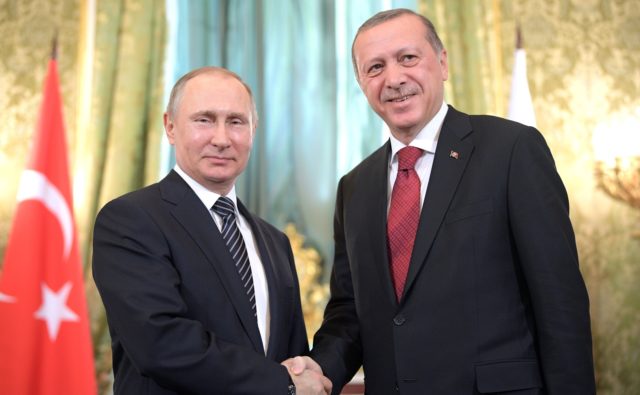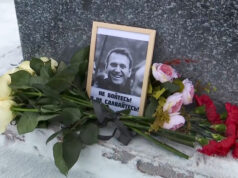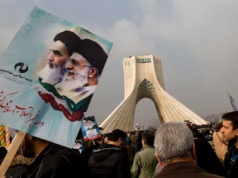
Recent developments in Russia’s relations with Middle Eastern states suggest an impending inflection point in those ties. Since 2015 when it intervened in Syria, Moscow has prospered in the Middle East. As virtually every analysis points out, Russia is now an indispensable and trusted interlocutor for almost every Middle Eastern state and has hitherto adroitly managed to avoid taking sides in any of the terrible consequences that pervade this region. As everyone’s “dialogue partner,” Russia has successfully made major political and strategic gains, obtained lucrative arms and energy contracts, consummated deals with OPEC (Organization of Petroleum Exporting Countries), become a reliable interlocutor for Iran and Israel, coordinated with Turkey in Syria, created enduring power projection capabilities, gained military bases in the Middle East and the Horn of Africa, and challenged the U.S. role as the “security manager” of the region. Moreover, it has made lucrative economic deals with many Gulf states to circumvent Western sanctions, and the UAE (United Arab Emirates) has become an enabler and “advertising agent” for Russian power projection in Africa.
However, new developments in Syria, and Moscow’s reckless and ill-advised “oil war” against Saudi Arabia that coincided with the onset of the coronavirus pandemic, may presage a reversal of fortune for Russia in the Middle East. These events have revealed the limits of its military and energy power to the world at large and may lead to a reconfiguration of Middle Eastern relations with Russia and of Russia’s policies in the Levant.
Syria and Turkey
In February-March 2020, Syrian forces aided by Russian aircraft launched an offensive against Turkey’s troops in Syria, a crisis stemming from the fundamental incompatibility of Russo-Turkish interests there. Russia’s interests are that President Bashar al-Assad regain control over all or as much as possible of Syria and ultimately eliminate the Idlib salient in the northwest that, on the basis of previous agreements with Turkey, contains the last remnant of Assad’s opposition who Moscow regularly calls terrorists. Thus, when Assad mounted this offensive into this zone, he was clearly supported by Moscow and the Russian Air Force that inflicted serious casualties on Turkish forces. According to a Ukrainian source:
Russia carried out a reform of the Assad forces, took full responsibility for reconnaissance, command, supply and air support, provided training of Iranian mercenaries and launched an offensive operation. The purpose of the operation is to penetrate Idlib through large gaps between Turkish strongholds and create their [own] strongholds. And with the support of Russian-Assad aviation, defeat the pro-Turkish forces without engaging in battle with the Turkish army. Thus, the Turks would be forced to enter into negotiations on a settlement in Idlib with [Russian President Vladimir] Putin and Assad, and Assad would be able to regain control there. The first key target of the offensive was the city of Serakib and the area around it, through which one of the strategic highways goes.
Nevertheless, Russia and Assad apparently miscalculated and Turkish President Recep Tayyip Erdogan refused to accept Assad’s offensive. Erdogan launched a counter-offensive that inflicted even greater losses on Syrian forces and their Russian-made equipment, forcing Russia to intervene diplomatically, and raising the prospect of a major Russo-Turkish clash. Previously, Russia had accepted accords on Idlib to give Assad time to gain control of other “liberated” areas. But now Russia’s resolve to destroy the “terrorists” and secure Assad’s rule clashed directly with Turkey’s plans to create a long-term buffer zone in Syria wherein it can resettle the millions of refugees who crossed into Turkey and have now become a burden for it, and also prevent the Syrian Kurdish YPG (People’s Protection Units), which it charges are terrorists, from linking up with Turkey’s own Kurdish opposition, the PKK (Kurdistan Workers’ Party).
Therefore, and despite the fact that Presidents Erdogan and Putin remain in close contact on Syria and other issues, there is no doubt that further crises will occur and that the agreements on March 5 to suspend the fighting are purely tactical. Moreover, both the Turkish and Russo-Syrian-Iranian sides have recruited terrorists, tribesmen, militias, etc. to their side, all the while charging that the other side is failing to suppress terrorism. The use of these proxies in Syria, as in Libya, can only increase the possibility of prospective resumption of fighting among the proxies that can then drag their sponsors into conflict, criticize him openly as happened in southern Syria. Consequently, we will see more crises and this struggle between the two incompatible visions of Syria’s future is by no means over.
Assad’s Hold on Power
Moreover, Assad’s insistence on recovering his authority over all of Syria without making any concessions to any faction in the country has finally led Russia to criticize him openly, if not in the name of the government. Indeed, we now hear reports (clearly authorized by the Russian government for publication, even if they are not verified) that Russia, Iran, and Turkey have all decided to unseat Assad. Since Assad cannot even pacify other areas of Syria, the civil war is not over despite a clear Russo-Syrian-Iranian victory over many of the rebels. In southern Syria, terrorist assassinations, killing many Syrian soldiers, continue with impunity. At the same time, Russia, Iran, and Turkey have each built up proxy forces in Syria – aside from their own regular forces – and the rivalry among Russian and Iranian proxies fuels the violence.
Each is striving for control over territory, rackets, and markets. Assad cannot stop the violence and the rival proxy forces will not stop it. Consequently, neither Assad, nor Iran, nor Russia can presently pacify Syria. That fact alone helps justify Turkey in its belief that it can and must set up this northern buffer to prevent more refugees and Syria’s Kurds from linking up to Turkey’s own Kurdish opposition.
In addition, since the pacification of Syria and the beginning of its reconstitution as a state are nowhere in sight, divisions among Russian policymakers have evidently surfaced. Allegedly, the Ministry of Defense and military-intelligence apparatus are fighting with the Ministry of Foreign Affairs and its research centers. The aforementioned public critique of Assad clearly represents the fact that those elements of the Russian government that are disenchanted with him have obtained political cover for expressing their views about his inflexibility and corruption in public to warn him that Moscow’s support may not be immutable. Moscow’s difficulties also come from Iran, which has communicated its unhappiness about being excluded from the March 5 agreements with Turkey and has long been unhappy that Moscow will not shield it from Israeli raids on its positions in Syria.
Thus, it is clear that Russian, Iranian, and Turkish military forces will continue to conduct operations in Syria. Moscow is even establishing a new helicopter airbase in northern Syria in Raqqa province. Helicopters are much more useful than strike aircraft for the kinds of low-level but deadly ambushes, skirmishes, and battles that can and will transpire in northern Syria. And this new base also represents a veiled warning to Turkey. While there have been at least seven of the newly established Russo-Turkish patrols in Syria agreed to under the March 5 plan, the plan itself failed to obtain a legal basis when the United States vetoed it in the UN Security Council. It remains, then, merely a bilateral agreement. There are numerous signs of domestic and rebel opposition to the patrols that will likely increase and interfere with their missions in the future. Therefore, it increasingly looks like Syria could become the quagmire President Barack Obama (albeit far too early) predicted it might become for Russia.
The Saudi Connection
In early 2020, Moscow also launched an oil war with Saudi Arabia. As the coronavirus forced declining energy demand in China, demand was already declining due to a warm winter, and American shale producers were capitalizing on energy prices of about $60-70 per barrel (Bbl.). Moscow spurned Riyadh’s offer of jointly cutting production to keep prices high. Instead, Moscow prepared to increase production and strike at Saudi and other OPEC members’ market share even though its real target was U.S. shale producers. At higher prices in 2019, American producers were cutting into Russian markets.
Given the high cost of shale production, Russia, and in particular Igor Sechin, boss of Russia’s energy giant Rosneft, attacked support for high prices as subsidizing these American producers. Sechin was also fuming because U.S. sanctions on Rosneft in Venezuela forced the company to sell its shares to the Russian state (netting Rosneft $9.6 billion). He wanted revenge. He also convinced President Putin that flooding markets with cheap oil would not only destroy American producers but also Saudi Arabia. He and his supporters believed that Saudi Arabia needed a price on oil twice that of Russia to make a profit, and therefore could not withstand Russian flooding of the market.
They made a catastrophic mistake. Saudi Arabia preempted Russia by flooding the market itself. As Riyadh is an old hand at the market share game this should have been predictable and it soon became clear that Saudi Arabia, not Russia, could better withstand the enormous plunge in prices precipitated by the coronavirus pandemic. Moscow ultimately had no choice but to accept a solution engineered by President Donald Trump (whose interest was in rescuing American producers). Demand has stayed low since March 2020 and prices are not going to rebound to $60/Bbl. any time soon. As a result, Moscow has suffered what can only be termed a catastrophic defeat. Its cash reserves are draining away. The ruble has fallen precipitously, and its economy is estimated to lose 5-6 percent of GDP this year. Worse yet, as of May, Saudi Arabia continued to undercut Russia in European, Asian, and even the U.S. market.
Conclusion
These developments may well presage an inflection point in Russian policy. To be sure Moscow is not leaving the Middle East. It has made serious investments in Syria and has gained leverage throughout the Middle East and Maghreb (Arab North Africa) and will fight to both maintain and extend its influence whenever possible. Nonetheless, its resources may not be up to the task.
The coronavirus is rampaging through Russia, eating up government savings and the economy. The state’s response, frankly, has been pathetic with Putin essentially hiding in his dacha. The defense budget, not to mention foreign adventurism, will come under severe pressure whatever the policy response.
Second, if Moscow really is thinking of ousting Assad, it eliminates the reason it intervened in the first place. If the Afghan, Iraqi, and Vietnamese examples are relevant, his ouster will not stabilize what has become an international proxy war on top of a civil war; a truly Hobbesian state. Moscow also cannot oust Turkey from Syria unless it wants a direct clash with Ankara. One-on-one in overall military strength Ankara is no match for Moscow. But in Syria, particularly if Erdogan closes the Straits (Dardanelles and Bosporus) as he has repeatedly threatened to do, that outcome might be reversed. Encouraging Iran in Syria carries its own risks, as Israel will not desist from destroying Iranian military infrastructure there and Moscow will not tangle with Israel to bail out Tehran.
At the same time, Riyadh now has reason to be even more suspicious of Moscow’s ambitions and judgement regarding energy and the Middle East, two closely interrelated issues. Russia’s continuing partnership with Iran against the United States has not previously dissuaded a Saudi-Russian dialogue and they cooperated on energy from 2016-19. But the last crisis exposed both the defects of Russian policymaking and Saudi Arabia’s ability to dominate energy markets with U.S. support, even if Washington had to twist its arm.
These events will redound not only through Syria and in bilateral relations with Syria, Saudi Arabia, Iran, and Turkey, but will have effects that go all the way to sub-Saharan Africa. Russian successes there were in no small measure due to its previous successes in the Middle East and those have now been seriously tarnished.
But the strategic stakes are too high for Moscow to abandon the field, and the structural pathologies of both regions that invite foreign intervention may actually get worse due to the coronavirus. Moreover, nothing is forever in the Middle East and all manner of astounding renversement des alliances (reversal of alliances) have occurred and may easily reoccur. Nevertheless, Moscow’s capabilities and judgment have taken a serious and lasting hit so it probably will not, despite its intentions, be able to cut the same figure in the Middle East as it has since 2015. Although we are living in interesting times, that does not mean that peace will break out in the Middle East. But we may be seeing the beginning of a new stage in that region’s endless dramas.
Stephen Blank, Ph.D., is a Senior Fellow at the Foreign Policy Research Institute.





